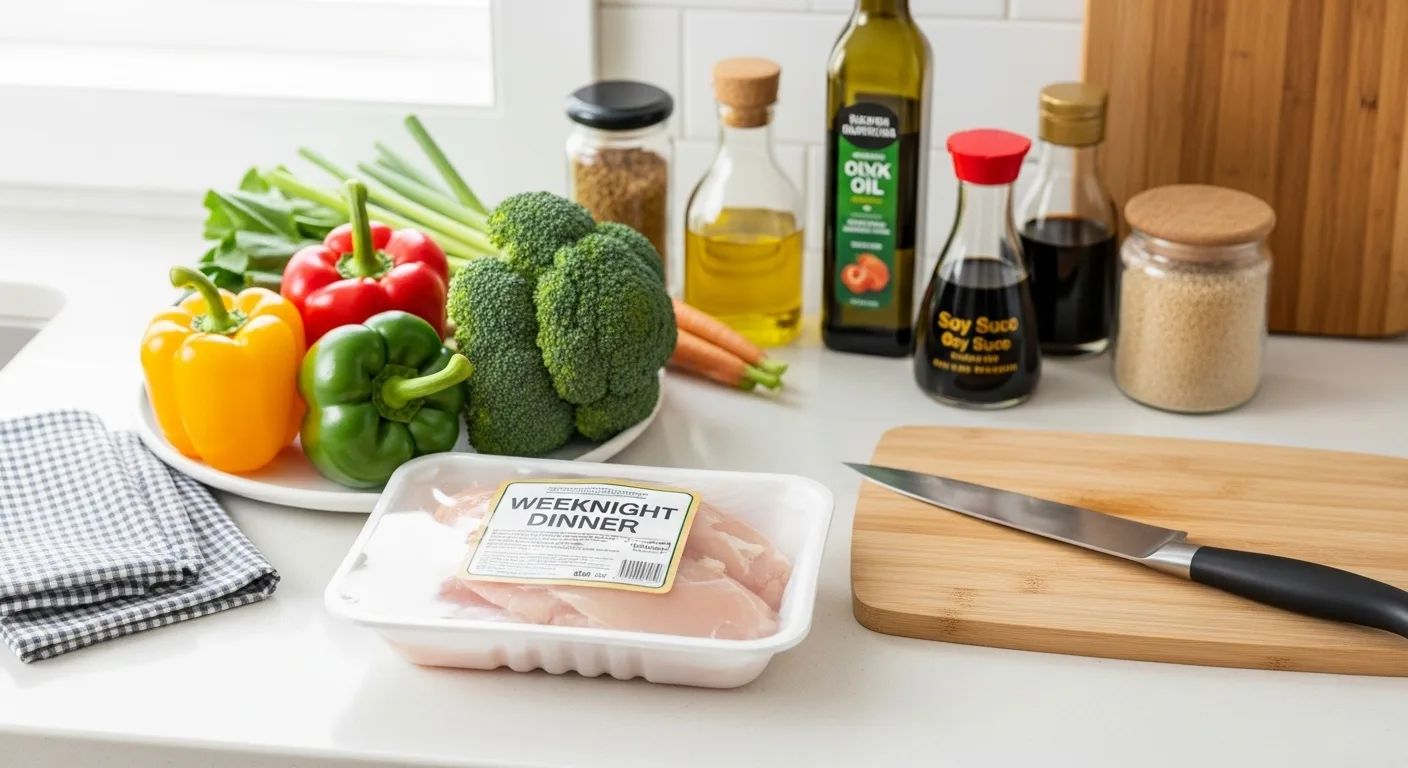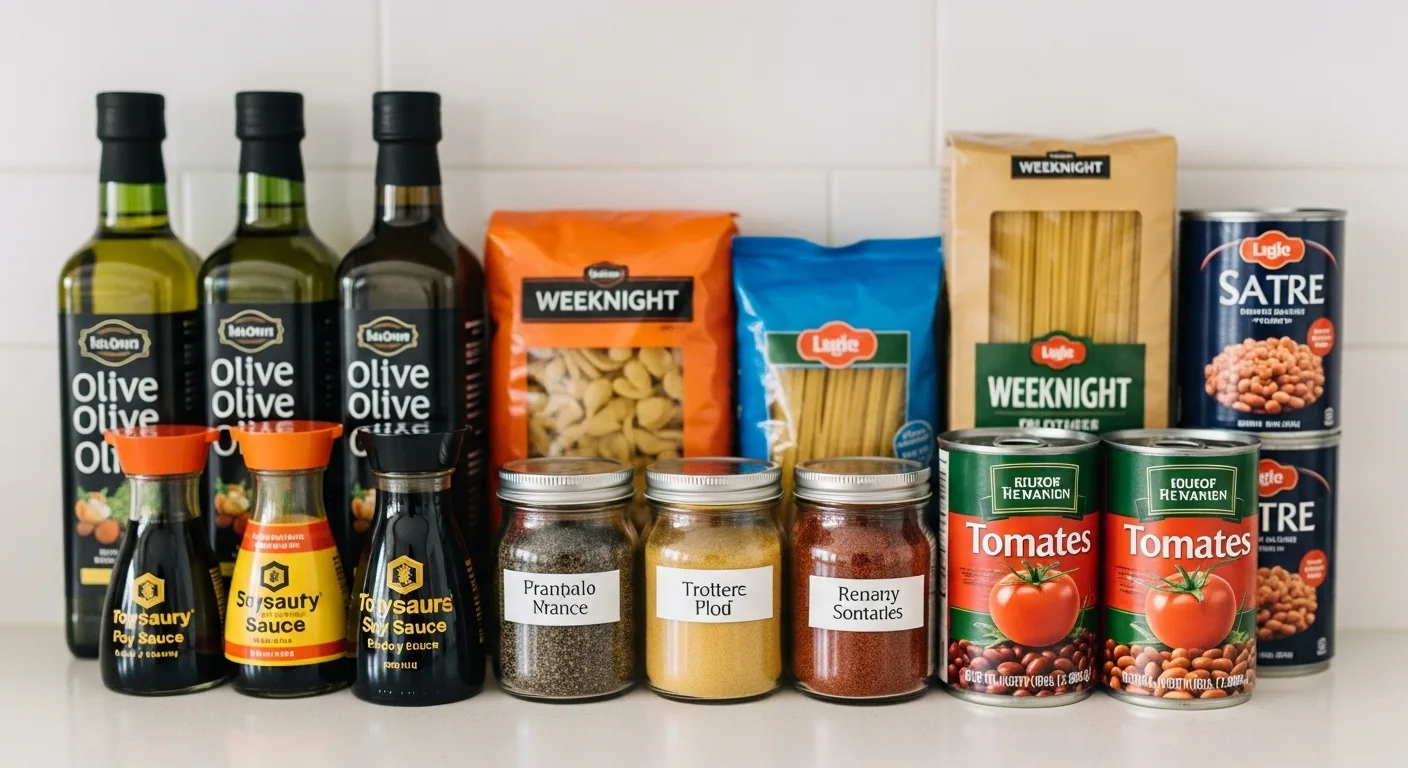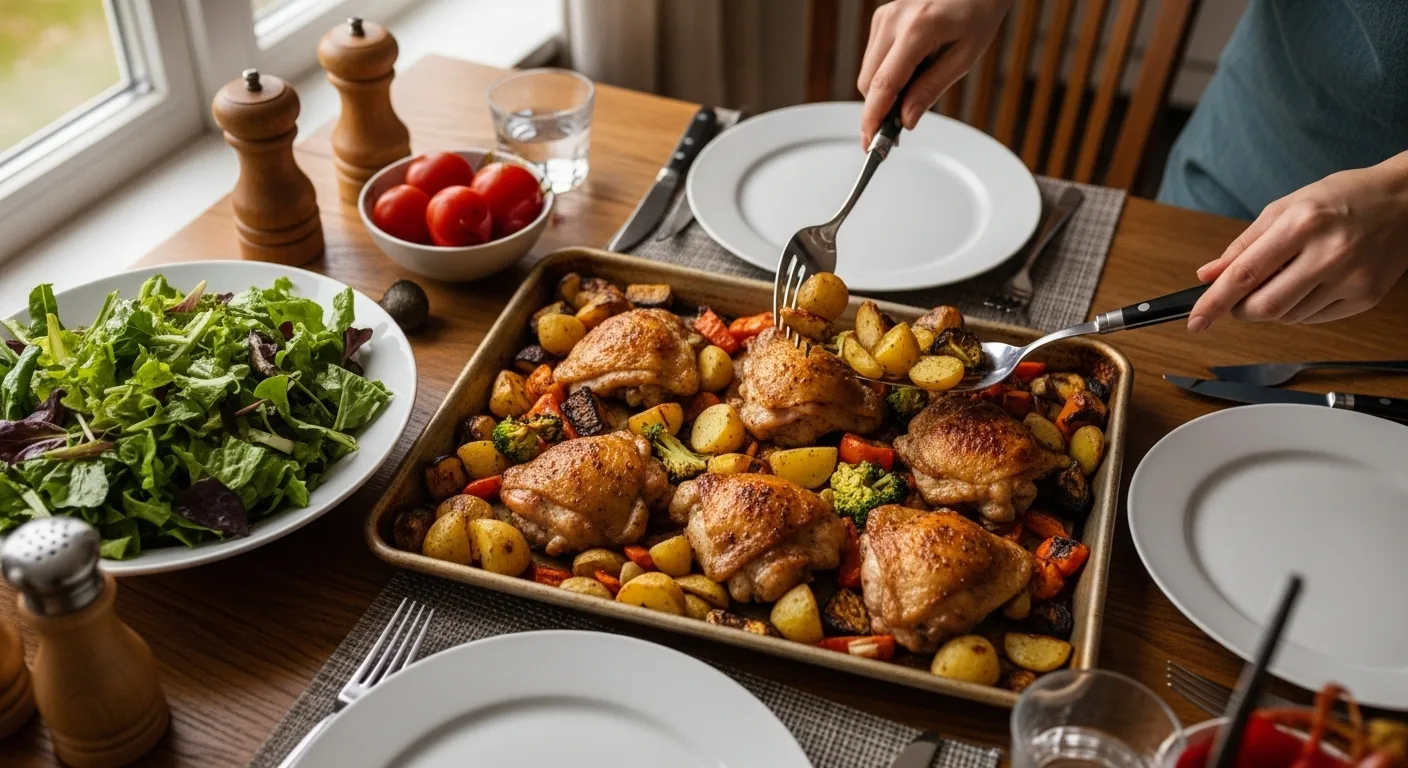The Reality of Weeknight Cooking (And Why Most Quick Recipe Sites Get It Wrong)
Here’s what nobody tells you about weeknight dinners: you’re not just fighting the clock—you’re battling decision fatigue, a fridge full of random ingredients, and the very real temptation to just order pizza again. I get it. I’ve stood in my kitchen at 6:47 PM, still in my work clothes, wondering how I’m supposed to summon the energy to “quickly whip up” some elaborate 30-minute meal that requires seventeen ingredients I don’t have.
After years of traveling, testing recipes, and actually living the reality of weeknight cooking (not just styling it for photos), I’ve learned something crucial: the best weeknight dinners aren’t about following complicated recipes. They’re about having a solid framework and knowing a few key techniques that work every single time. Real talk—some of my most satisfying weeknight dinners have come together in twenty minutes with five ingredients, and they’ve tasted better than anything I spent hours on during the weekend.
So let me share what actually works. Not the fantasy version where you have a perfectly stocked pantry and endless energy, but the real-world version where you’re tired, hungry, and need something delicious on the table fast.
What Makes a Weeknight Dinner Actually Work
You know that moment when you find a recipe that promises to be quick, and then paragraph three mentions “marinating overnight” or “if you have homemade stock on hand”? Yeah, that’s not a weeknight dinner—that’s a project masquerading as convenience.
Real weeknight dinners have three non-negotiable qualities:
They use ingredients you actually keep around. I’m talking pantry staples, frozen vegetables, proteins you can grab at any grocery store. When I came back from a month in Greece, I was obsessed with recreating these elaborate dishes—until I realized nobody has time to hunt down specialty ingredients on a Tuesday. Now I focus on what’s realistic.
They have minimal prep and fewer dishes. Listen, this is important: if a “quick” recipe dirties four pots, three cutting boards, and makes you pull out your food processor, it’s not actually saving you time. The best weeknight dinners happen mostly in one pan, one pot, or one sheet tray. Period.
They taste like you actually tried. The biggest mistake people make with quick cooking is thinking fast has to mean bland. The women who taught me to cook—from my abuela to the home cooks I’ve learned from across Latin America—they never had hours to spend on dinner, but their food was always packed with flavor. They knew the shortcuts that actually work.
The Three Core Techniques That Changed Everything
Something magical happens when you master just three fundamental approaches to weeknight dinners. Suddenly you’re not following recipes anymore—you’re creating meals based on what you have and what sounds good.
The Sheet Pan Power Move

I spent years complicating dinner until a Turkish friend showed me how she fed her family: everything on one pan, high heat, done. Protein plus vegetables plus good olive oil and spices. That’s it. The oven does all the work while you change clothes or help with homework.
The key nobody mentions? You need real heat—425°F minimum. Don’t be timid. And here’s my insider secret: cut everything roughly the same size so it cooks evenly. I’ve seen so many people frustrated because their potatoes are still raw while their chicken is overcooked. Uniform sizing solves this.
My go-to formula: Season chicken thighs (or salmon, or chickpeas) with whatever spices you’re feeling—smoked paprika and garlic powder is my default. Toss halved baby potatoes and whatever vegetables need using up (Brussels sprouts, broccoli, bell peppers) with olive oil, salt, and pepper. Spread everything on a sheet pan. Roast 25-30 minutes. Done. You just made dinner without standing over a stove.
The Stir-Fry Secret (It’s Not What You Think)
Real stir-fries—the kind I learned eating street food through Vietnam and watching home cooks in Bangkok—don’t require a wok or specialty ingredients. They require really high heat and speed. That’s the secret.
Here’s how I approach weeknight stir-fries now: Get your pan screaming hot. Cook your protein first in batches (don’t crowd it), remove it. Then toss in heartier vegetables (like broccoli or snap peas), then softer ones (like spinach), then garlic at the very end. Return the protein, add your sauce, done in twelve minutes.
The sauce formula I use constantly: equal parts soy sauce and water, a spoonful of whatever you have (honey, brown sugar, hoisin), a squeeze of lime or splash of rice vinegar, and a little cornstarch mixed in cold water to thicken it. Boom—that’s better than most takeout and costs a fraction of the price.
The Pasta Technique Nobody Teaches
I learned this from watching how Southern Italian grandmothers make weeknight dinners, and it completely transformed my relationship with pasta. You’re not making a sauce separately—you’re building flavor directly in the pan and finishing the pasta right in that sauce.
Start with olive oil or butter in a big skillet. Add aromatics (garlic, shallots, whatever). Then either tinned tomatoes, or pasta water with butter, or cream—whatever direction you’re going. Cook your pasta until it’s two minutes away from done, then transfer it directly to your sauce pan with tongs (bring some pasta water with it). Finish cooking the pasta in the sauce, adding pasta water as needed. The starch thickens everything, the pasta absorbs the flavors, and you get restaurant-quality results in the time it takes the pasta to cook.
Pro tip: frozen vegetables are your friend here. I always have frozen peas, spinach, and artichoke hearts. They go straight into the pan—no thawing needed.
My Essential Weeknight Dinner Framework (Copy This)

After testing hundreds of quick recipes, I’ve developed a framework that works no matter what’s in your fridge. Think of it as a template you can customize infinitely.
Pick your protein: Chicken thighs, ground meat, shrimp, eggs, chickpeas, or tofu. These all cook quickly. I keep chicken thighs and ground beef in my freezer constantly—they’re versatile and forgiving.
Choose your vehicle: Pasta, rice (use instant or leftover), bread (for sandwiches or toasts), tortillas, or just serve over greens. Don’t overthink this.
Add bulk and nutrition: Whatever vegetables you have. Frozen count. Tinned tomatoes count. Bagged salad mix counts. We’re going for balance, not perfection.
Layer in flavor: This is where people usually fail with quick cooking. You need fat (olive oil, butter, coconut oil), salt (actually season things properly), acid (lemon, lime, vinegar), and usually something savory-sweet (soy sauce, fish sauce, tomato paste, miso).
Using this framework, I can open my fridge with random ingredients and make dinner happen. Last week it was: ground turkey + instant rice + frozen mixed vegetables + soy sauce and sesame oil. Took eighteen minutes, tasted like I’d ordered in.
The Weeknight Dinners I Make on Repeat
Let me share the actual recipes that have saved me countless times. These aren’t aspirational—they’re the meals I genuinely make when I’m exhausted.
Fifteen-Minute Lemon Garlic Shrimp Pasta: Boil pasta. Meanwhile, sauté shrimp with tons of garlic and red pepper flakes in butter and olive oil. Toss with pasta, lemon juice, lemon zest, pasta water, and whatever green vegetable you have (I usually throw in frozen peas or fresh spinach). Finish with parmesan. This is the dinner I make when I need to remember why I love cooking.
Sheet Pan Chicken Fajitas: Slice bell peppers and onions (don’t stress about perfect slices—rustic works). Toss with chicken strips, cumin, chili powder, garlic powder, olive oil. Roast at 425°F for twenty-two minutes. Serve with tortillas and whatever toppings you have—sour cream, cheese, salsa, avocado. My kids request this weekly.
Fried Rice With Whatever: This is my “fridge clean-out” dinner. Heat oil in a big skillet, scramble eggs and remove them. Add whatever vegetables need using (I’ve used everything from frozen mixed vegetables to leftover roasted broccoli). Add cold leftover rice (or instant rice prepared earlier), soy sauce, sesame oil, maybe some frozen peas. Stir in those eggs at the end. Takes twelve minutes and uses up odds and ends.
Creamy Tomato Chickpea Curry: Sauté onion and garlic, add curry powder (or garam masala if you have it) and tomato paste, stir for a minute. Add tinned tomatoes, tinned chickpeas (drained), and a splash of coconut milk or cream. Simmer ten minutes. Serve over rice with naan bread if you have it. This tastes like it took hours and costs almost nothing.
Common Weeknight Dinner Mistakes (I’ve Made Them All)
Listen, I’ve failed at quick cooking in every possible way. Here’s what I learned from those disasters:
Mistake #1: Following recipes too literally. If you’re missing one ingredient, don’t abandon ship. Almost everything is swappable. No fish sauce? Use soy sauce. No fresh herbs? Dried work fine. The recipe police aren’t coming to your house.
Mistake #2: Not seasoning properly. Fast cooking often means less time for flavors to develop, so you need to be more aggressive with seasoning. Salt, acid (lemon or vinegar), and garlic powder are your best friends. Taste as you go.
Mistake #3: Starting to cook before you’re ready. I know you’re in a hurry, but those three minutes you spend getting everything prepped—protein sliced, vegetables cut, sauces mixed—will save you ten minutes of scrambling around a hot stove with something burning. Ask me how I know.
Mistake #4: Trying to make it perfect. Some nights, “good enough” is absolutely good enough. Frozen vegetables instead of fresh? Fine. Store-bought rotisserie chicken? Perfect. Boxed broth? Nobody will know. Save the perfectionism for the weekend.
Building Your Weeknight Dinners Pantry

You don’t need a massive pantry, but you do need the right staples. Here’s what I always keep stocked:
In the pantry: Good olive oil, pasta (multiple shapes), instant rice, tinned tomatoes, tinned beans, soy sauce, garlic powder, onion powder, cumin, chili powder, Italian seasoning. That’s the foundation of probably 70% of my weeknight dinners.
In the freezer: Chicken thighs, ground beef or turkey, shrimp, frozen mixed vegetables, frozen peas, frozen spinach, frozen bell pepper strips. These never go bad and you always have protein and vegetables available.
In the fridge: Butter, eggs, parmesan cheese, lemons (or bottled lemon juice), garlic, onions, whatever fresh vegetables looked good at the store. This is your variable section—it changes weekly based on sales and what’s in season.
With these items, you can make hundreds of different weeknight dinners without special shopping trips. That’s the freedom right there.
Making Weeknight Dinners Work for Your Life
The best advice I can give you about weeknight dinners? Stop comparing yourself to food bloggers who photograph their “quick” meals in perfect lighting with handmade ceramics. That’s not real life, and it’s certainly not what dinner looks like when you’re hungry and tired.
Your goal isn’t perfection—it’s getting decent food on the table without losing your mind. Some nights that’s a beautiful sheet pan meal with roasted vegetables. Other nights it’s scrambled eggs and toast. Both are absolutely valid weeknight dinners.
I’ve cooked in home kitchens from Morocco to Mexico City, and you know what I’ve learned? The best home cooks aren’t the ones with the fanciest techniques—they’re the ones who can consistently get good food on the table with whatever they have on hand. That’s the skill worth developing.
So start with one or two of these approaches this week. Master the sheet pan dinner. Get comfortable with your stir-fry formula. Build your pantry gradually. Before you know it, weeknight dinners won’t feel like a problem to solve—they’ll just be part of your rhythm.
And on those nights when nothing comes together and you order pizza? That’s okay too. Tomorrow’s another dinner. You’ve got this.

